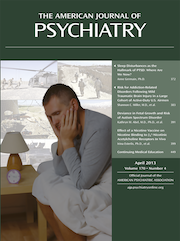In This Issue
Telemedicine-Based Depression Care
Telemedicine-based collaborative care for depression in family practice delivered by nurses at a remote central location produced higher rates of remission and response than care by identically trained nurses working on site in the clinics (figure). The number of visits and the quality of pharmacotherapy did not differ between the groups studied by Fortney et al. (CME, p. Original article: 414). Off-site care managers were more likely to follow the protocol for monitoring patients’ symptoms and treatment and providing information and suggestions. Editorialists Simon and Ludman (p. Original article: 362) anticipate overall treatment improvements from other comparisons of centralized and localized care.

Differences in outcome were not due to medication or psychotherapy (Fortney et al., p. Original article: 414)
Alleviating insomnia or sleep disruptions with pharmacological or behavioral treatment may itself reduce daytime symptoms of posttraumatic stress disorder (PTSD), anxiety, and depression. It may also increase the efficacy of primary PTSD treatments, especially cognitive-behavioral approaches relying on habituation or cognitive processing, which are markedly affected by sleep loss. The antihypertensive prazosin and imagery rehearsal therapy are recommended for PTSD-related nightmares. Combined behavioral treatments for nightmares and insomnia in PTSD patients may also be effective. Germain (CME, p. Original article: 372) recommends clinical interviews, self-report measures, or sleep diaries for evaluating sleep complaints unless sleep-disordered breathing is suspected.
Late-onset agranulocytosis during clozapine treatment is rare. A literature search by Cohen and Monden (p. Original article: 366) revealed only 16 patients since 1980 who developed agranulocytosis more than a year after beginning clozapine treatment. They report an additional case, appearing 19 years after the start of clozapine monotherapy. The majority of cases involved co-treatment with other medications, including valproate, but no specific drug has been shown to increase risk. The incidence of agranulocytosis during long-term clozapine treatment is only 1 case per 1,000 patient-years, which is comparable to rates for typical antipsychotics. Whereas the U.S. requires white blood cell and absolute neutrophil counts every 4 weeks after the first year of treatment, the Netherlands now permits informed mentally competent patients to lower the frequency of blood tests to four times a year.
Substance Use After Mild Brain Injury
New diagnoses of alcohol dependence were more common among U.S. Air Force personnel with mild traumatic brain injury (TBI) than in those with other types of injuries. In the 30 days following the injury, both alcohol dependence and nondependent drug or alcohol abuse were diagnosed more often in the airmen with mild TBI. Miller et al. (p. Original article: 383) report that the higher incidence of alcohol dependence in brain-injured service members continued into later periods as well. The editorial by Corrigan et al. (p. Original article: 351) emphasizes the prevalence of substance use disorders among service members and suggests that traumatic brain injury may occur in the context of substance use.
Nicotine Vaccine Reduces Receptor Binding
Immunization with a nicotine vaccine over 20 weeks led to an average 12.5% reduction in the binding of administered nicotine to β2*-nicotinic acetylcholine receptors in the brains of 11 long-term smokers. The decline in receptor occupancy was accompanied by a 23.6% decrease in the amount of nicotine available to enter the brain. This proof-of-concept study by Esterlis et al. (CME, p. Original article: 399) also documented decreases in craving and the number of cigarettes smoked, although earlier clinical trials did not support the vaccine’s efficacy in smoking cessation. Fagerström and Tonstad point out in an editorial (p. Original article: 359) that factors other than nicotine also contribute to smoking behavior.



